http://www.chemistrymag.org/cji/2001/03c058pe.htm |
Dec. 1,
2001 Vol.3 No.12 P.58 Copyright |
On the phase inversion of polypropylene/polystyrene blends
Xie Zhimin, Wan Zhimin#, Sheng Jing
(School of Materials Science and Engineering, Tianjin University, Tianjin 300072, China; #Analysis
and Measurement Center, Harbin Institute of Technology, Harbin 150001, China)
Received Jun.
28, 2001Abstract This article
focused on the phase inversion of immiscible Polypropylene/Polystyrene blends. A
mechanical model has been proposed to determine the point of phase inversion. On the basis
of the assumption that the ultimate strength will be controlled by dispersed phase when
the blend has more volume fraction than the minimum fraction, the minimum fraction of
dispersed phase calculated in terms of the properties of the pure components was found
close to the phase inversion region determined by observing the blends morphologies. It is
confirmed that the blends have a stationary mechanical property at the phase inversion
region. In addition, the point of inversion computed by using the rheological method
showed a good agreement with the proposed mechanical prediction.
Keywords phase inversion, immiscible blends, mechanical property
In today's polymer industry, the importance of polymer blends is unquestionable. Most polymer blends are immiscible and have a distinct dispersed phase[1]. When the volume fraction of the dispersed phase increases, at certain concentration a structural transition in a melt flow structure takes place[2]. The studies on emulsions of oil and water are an example of such a phase inversion. In the oil-water system there exists a narrow interval volume fraction where the co-continuous phase structure can be observed. As for the polymer blends, the phase inversion interval is known to be quite wide. The only operationally applicable definition of the phase inversion point has been given in many literatures[2,3]. Veenstra et al.[4] have shown that co-continuous morphologies are not formed at a point of phase inversion, but rather over a range of volume fractions which strongly depends on the processing conditions and the rheological properties of the components. Lyngaae-Jorgensen et al.[2] investigated the critical volume fraction for interpenetrating phase structure formation during flow. Ratnagiri and Scott[3] studied the effect of rheology of the minor component on its tendency to form a continuous phase at short mixing times, showing that phase inversion can occur even with a low-melting major component during compounding. Since the macroscopic mechanical properties of the blends are strongly dependent on the component properties, compositions, and microstructure such as dispersion of minor component and interfacial phase, it is anticipated that the blends have a clearly change in properties at the phase inversion region[5]. In view of the morphology-property relation, the present work is concerned with the determination of the phase inversion in terms of the immiscible blends polypropylene/polystyrene(PP/PS) by means of the SEM observation, mechanics of materials and rheology.
2 EXPERIMENTAL
PS with molecular weight ![]() =5.8×10
=5.8×10
PS and PP were dried at 80°C for 4 hours and blended in a mixed apparatus (Model XXS-30, China) at 30rpm and 220°C for mixing time 5min. In this processing condition, the shear rate was evaluated nearly 48s-1. Plates of the blends, PS and PP were compressed in a common heated press at about 20MPa, T=180°C for 1min and then cooled under pressure 20MPa with a resident time of 5min at room temperature. The plates were punched to several dumbbell shape specimens for mechanical tests. Pieces of the plate were broken in liquid nitrogen and the fracture surfaces were etched with acetone with a resident time of 1 min. They were then coated with Au-Pd for observation in a SEM(HITACHI X-650, Japan). Tensile tests were conducted with an Instron Tester (model 1186) at a cross-head speed of 5mm/min and ambient temperature of 25°C. An average of approximately six samples was used for each property.
Table 1 Properties of the Polypropylene and Polystyrene
Polypropylene |
Polystyrene |
|
Modulus (MPa) |
940 |
2958 |
Strength (MPa) |
25.7 |
30.2 |
Viscosity (Pa× s) |
1484 |
866 |
3 METHOD OF MECHANICS
Many factors such as constitutive material, interfacial properties, and homogeneity of
dispersed phase have significantly effect on the strength. The present work is concerned
with the effect of component strength and composition on tensile strength of
plastics/plastics blends.
Without loss in generality, the stress-strain curves for two
constitutive materials are shown schematically in Fig. 1. It is anticipated that there
exists a certain minimum volume fraction f
s*U =fms*m (1)
where superscript (*) denotes ultimate quantity, subscript m, d denote the matrix and dispersed phase, respectively.
With the increase of composition of dispersed phase, the morphology will be changed. Once the volume fraction of dispersed phase exceeds the minimum value, we suggest that the blend strength will be transferred to be controlled by the dispersed phase deformation. The corresponding ultimate strength is then expressed by: s*U = fds*d+fmsm (2)
where sm is matrix stress at a matrix strain equal to the ultimate strain in the dispersed phase. Combining Equ.(1) with Equ.(2) and applying f
m+fd=1 yields the minimum fraction or namely the phase inversion point fmin=(s*m-sm)/(s*d+s*m-sm) (3)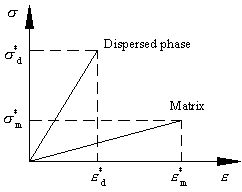
Fig.1 Schematic stress-strain curves
4 RESULTS AND DISCUSSIONS
Variations of typical morphologies with the ratio of components of the blends of PP/PS are
shown in Fig. 2. At low volume fraction of dispersed phase, the morphology has the
appearance of particle/matrix. As expected, the co-continuous morphology can be found at
the PP/PS(vol%)=60/40, 50/50 and 40/60.
It is assumed that polypropylene is elastic-perfectly plastic or
elastic-plastic. Then the polypropylene would fail at the yield point and its yield
strength is considered as the tensile strength. As for the PS, the fracture strength is
taken as its tensile strength since the PS fails in a brittle fracture mode at room
temperature. The experimental strength and modulus as well as the viscosity at shear rate
48s-1 and temperature 180° C of the PS and PP were listed in table 1.
According to the Hooke's law, the failure strain can be calculated easily, e*d=1.0%
for the PS and e*m
Moreover, the point of phase inversion was calculated considering the rheological properties of the components, PP and PS as follows[3], fPS /fPP= hPS /hPP (4)
with fPP+fPS=1 where the subscript denotes the component, h represents the viscosities and f the volume fraction. It should be noted that the long-mixing-time are essential. In this work, 5min of mixing may be long enough, we suggested, to form a steady-state morphology. The point of phase inversion was then computed by the Equ.(4) here about fPS =0.37, which agrees to the SEM observation and the mechanical prediction. Of these methods the SEM can provide a range of visual phase inversion whereas the others not.
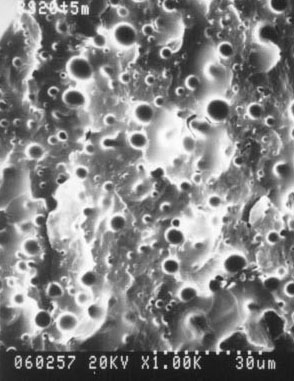
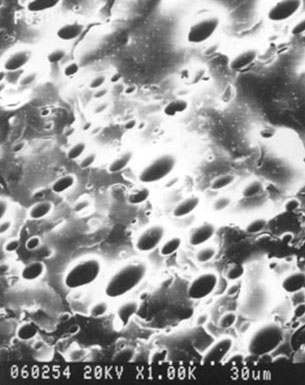
(a) 80/20 (b) 70/30
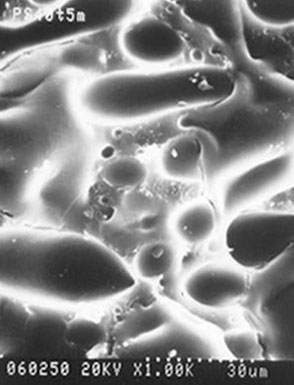
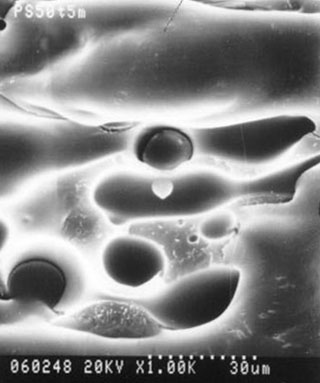
(c) 60/40 (d) 50/50
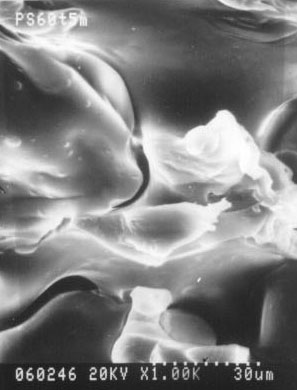
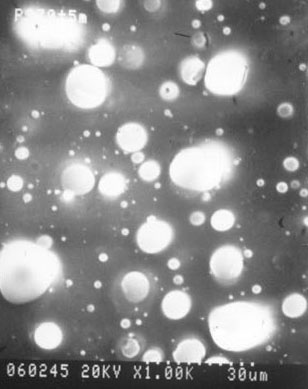
(e) 40/60 (f) 30/70
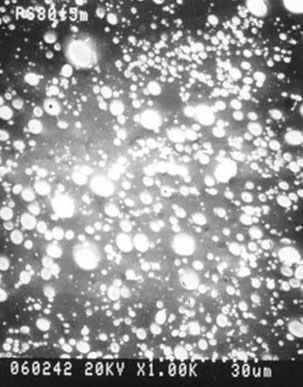
(g) 20/80
Fig.2 SEM graphs for series of PP/PS blends with mixer resident time 5min
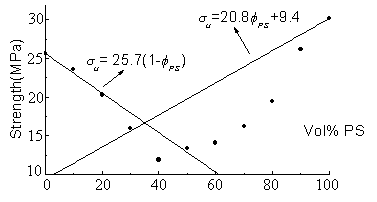
Fig.3 Relation between tensile strength and composition,
5 CONCLUSIONS
The phase inversion of immiscible Polypropylene/Polystyrene blends was studies by the SEM
observation, mechanics of materials and rheology. The ultimate strengths were predicted in
terms of pure component strength and composition, and the minimum fraction of dispersed
phase calculated was found close to the phase inversion region determined by observing
blend morphologies. It is confirmed that the blend will have a stationary mechanical
property in the phase inversion region. In addition, the point of inversion computed by
using the rheological method showed a good agreement with the proposed mechanical
prediction.
REFERENCES
[1] Belanger C, Cielo P, Favis B D et al. Polym Eng Sci., 1992, 32: 1886-1895.
[2] Lyngaae-Jorgensen J, Rasmussen K L, Chtcherbakova E A et al. Polym Eng Sci., 1999, 39:
1060-1071.
[3] Ratnagiri R, Scott C E. Polym Eng Sci., 1998, 38: 1751-1762.
[4] Veenstra H, Verkooijen P C J, van Lent B J J et al. Polymer., 2000, 41: 1817-1826.
[5] Xie Z, Wan Z, Sheng J. J Macromol Sci.-Phys., 2001, B40: 225-235.
[6] Zhou J. MS thesis , Tianjin University, 1999.